Term 3 Chapter 1 | 5th Science - Our Environment | 5th Science : Term 3 Unit 1 : Our Environment
Chapter: 5th Science : Term 3 Unit 1 : Our Environment
Our Environment
UNIT 1
OUR ENVIRONMENT

Learning Objectives
After the completion of this lesson,
students will be able to:
* Know about different types of farms.
* List out the economic importance of
dairy farms and poultry farms.
* Know about Apiculture and the uses of
honey.
* Understand the different types of
manures and their uses.
* Know about vermiculture and
vermicompost.
Introduction
Environment is everything that is around
us. There are two types of environment. They are physical environment and
biological environment. Physical environment includes all non-living things
like land, water and air. Biological environment includes the living things
such as plants and animals. Natural environment has lot of economic values.
Plants and animals in our environment are useful to us in a number of ways.
Animals like cow, buffalo and goat give us milk. Some animals are used for
transportation. These animals are raised in farms. In this lesson we will learn
about dairy farms, poultry farms, apiculture, manures and vermicompost.
I. Farms
Farming is the activity of growing crops
and raising livestock. It is a part of agriculture. Agriculture is the
cultivation of land and breeding of animals and plants to provide food, fiber,
woods and medicinal plants to sustain and enhance life. But, farming is more
profitable than agriculture. So it is done on a commercial scale. An area of
land with fields and buildings that is devoted primarily to growing crops or
raising domestic animals or both as a business is called farm. Large scale
farms grow one or two major crops or animals. Middle sized and small sized
farms grow different types of crops and animals.
1. Dairy Farm
Dairy farming is a type of agriculture
that focuses on extraction of milk and preparation of various milk products
like cheese, butter, curd etc. High milk producing cows along with bulls and
oxen are raised in commercial dairy farms. Other animals found in these farms
include goats, sheep and camels.
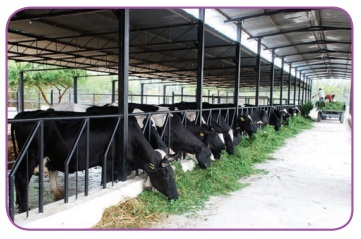
Do you know?
‘District Livestock Farm in
Hosur, Krishnagiri district of Tamil Nadu, is the biggest cattle farm in Asia.
Total area of this farm is 1641 acres.
Activity 1
Visit an animal farm in
your area and prepare a list of animals domesticated there. Also find out the
products you can get from there.
* Cattle breeds
![]() In India there are 26 cattle breeds. They are domesticated for
milk, agricultural work, transportation and many other needs. Gir, Sahiwal, Red
Sindhi, Kangayam and Ongole are some of the cattle breeds found in India.
Cattle breeds found in different states of India are given in the table.
In India there are 26 cattle breeds. They are domesticated for
milk, agricultural work, transportation and many other needs. Gir, Sahiwal, Red
Sindhi, Kangayam and Ongole are some of the cattle breeds found in India.
Cattle breeds found in different states of India are given in the table.
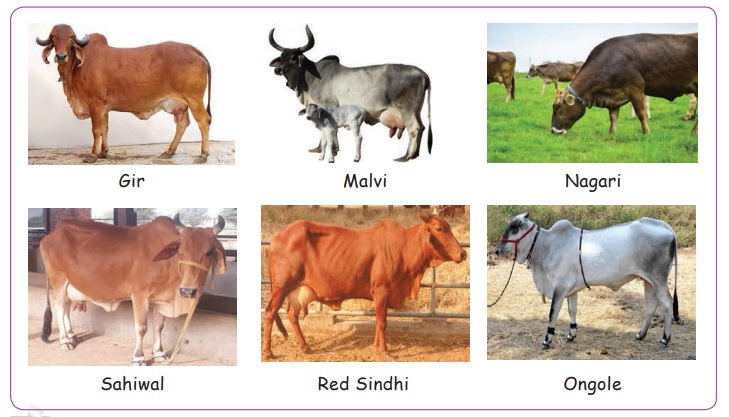
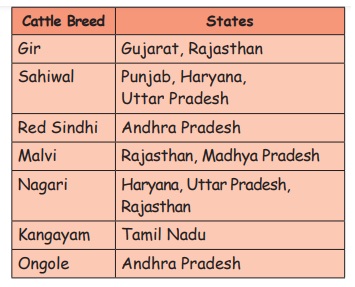
Cattle
Breed : States
Gir - Gujarat, Rajasthan
Sahiwal - Punjab, Haryana, Uttar Pradesh
Red Sindhi - Andhra Pradesh
Malvi - Rajasthan, Madhya Pradesh
Nagari - Haryana, Uttar Pradesh,
Rajasthan
Kangayam - Tamil Nadu
Ongole - Andhra Pradesh
Do you know?
India has the largest
number of livestock in the world, holding 281 million. In 2008, our country
housed the second largest number of cattle in the world with 175 million. (One
million = Ten lakh)
Activity 2
Some of the cattle breeds
found in Tamil Nadu are given below.
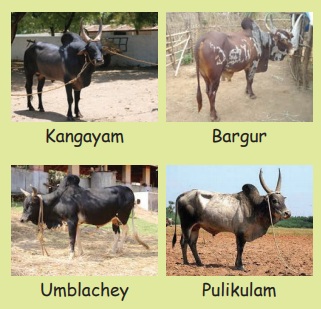
With the help of your
teacher find out the districts where they are found.
Apart
from these animals, buffaloes are also domesticated in India. There are 7
buffalo breeds in India. Buffaloes produce more amount of milk than cows. Also,
buffalo milk has more nutrients than cow’s milk. Murrah, Jaffrabadi, Bhadawari
and Surti are the buffalo breeds that are found in India. India is the biggest
buffalo milk producer in the world. Some of the buffalo breeds found in our
country are given in the table.
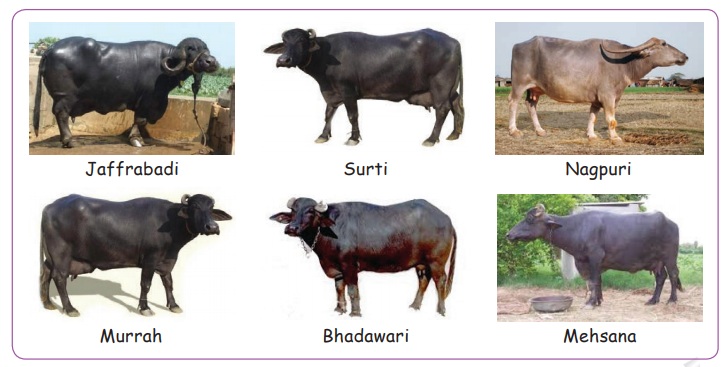
Do you know?
White Revolution in India
was launched in 1970s to make India self dependent in milk production.
Dr. Verghese Kurien is called the Father of White Revolution.
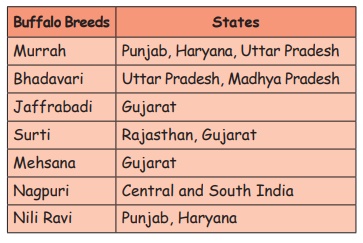
Buffalo
Breeds : States
Murrah :
Punjab, Haryana, Uttar Pradesh
Bhadavari :
Uttar Pradesh, Madhya Pradesh
Jaffrabadi :
Gujarat
Surti : Rajasthan, Gujarat
Mehsana :
Gujarat
Nagpuri :
Central and South India
Nili Ravi :
Punjab, Haryana
* Feeding
Cattle
need nutritious feed in order to be healthy and to produce high milk yield. The
cattle feed includes roughage and concentrates. The roughage contains high amount of fiber and it includes
fodder, hay, straw and silage. Concentrates include broken grams, cereals, millets, rice polish, cotton seeds and
oil cakes. Apart from these feed, cattle need an adequate amount of fresh
water.
* Diseases
Foot and
mouth disease and anthrax are some of the common diseases found among cattle.
Maintaining proper sanitation is necessary to stop the spread of these
diseases. Timely vaccination can prevent most of the diseases. Veterinary
medicine deals with the prevention, diagnosis and treatment of disease,
disorder and injury for domestic and non-domestic animals.
Activity 3
Visit a veterinary
hospital in your area and find out the common diseases found among the cattle
in your area. Try to know how such diseases can be prevented.
* Uses
Cattle are
useful to us in a number of ways. Some of them are listed below.
→
We get milk from cows.
Cow’s milk contains essential minerals needed for us.
→
Bullocks are used to plough land,
harvest and thrash crops.
→
Cattle are employed in
transportation.
→
Cattle dung is used as
manure. It is also used as fuel and for generation of biogas.
→
Panchagavya is an ayurvedic medicine
used in agriculture to control pest and fungi. It is a mixer of dung and urine of cows, fresh
milk, curd, jaggary and ghee.
→
Leather goods are manufactured from
cattle hides.

2. Poultry Farms
In poultry farms avian species are
reared and bred for the purpose of egg, meat or both. Fowls, ducks, geese,
turkeys and some verities of pigeon are the most commonly reared species.
Chicken occupy 90% of the total poultry. Poultry birds grown for meat are
called broilers. Layers are the female fowls grown for egg production. The poultry
industry is important in providing a balanced diet for human population. Proper
management of poultry includes methods of hatching, rearing, housing,
sanitation, prevention of diseases and a sound marketing system. In Tamil Nadu
famous poultry farms are found in places like Namakal, Palladam and Chennai.
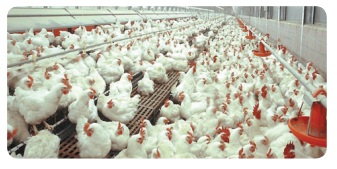
* Breeds
There are more than hundred breeds of
fouls. Fowls are classified on the basis of their utility to man. They are:
meat type (broiler), egg type (egg layer) and dual type. Assel, Chittagong,
Ghagus, Busra, Brahma and Cochin are some of the breeds found in our country.
Local and indigenous birds are reared in rural places. Traditionally these
birds have a poor meat production capacity compared to commercial broiler and
layers. But meat and egg from this type of poultry is better than other
commercial poultry.
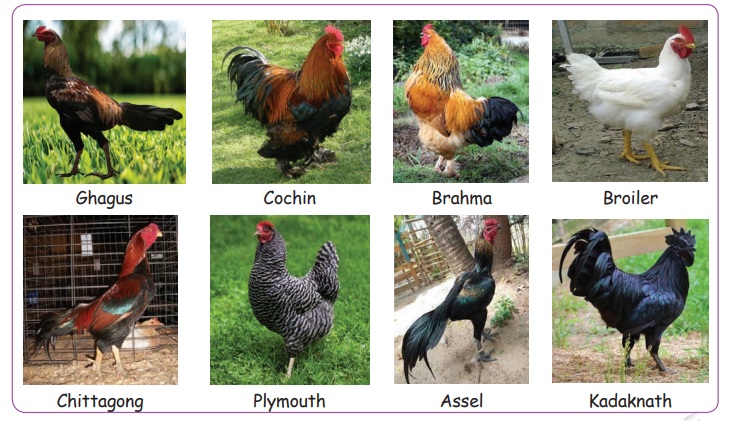
Do you know?
India ranks fifth in poultry production in the world. White legon is the most egg yielding breed in the world.
* Feeding
Poultry
birds need proteins, carbohydrates, fats, minerals and vitamins for egg and
meat production. Bajra, barley, maize, wheat, rice bran, jowar, oil cake, fish
meal, bread and green residues of vegetables are the feed given to the poultry
birds.
* Poultry products
Poultry
birds benefit us in many ways. Egg, meat and manure are the three main
benefits we get from them.
→
Poultry birds are good source of
nutritive food.
→
Eggs laid by them are rich source of
protien. These are easily digestable. They contain minerals like calcium,
potassium and iron, vitamins and moderate amount of fat.
→
Their feathers are used for making
pillows and quilts.
→
Dropping of the poultry birds is used
as manure. It is highly valuable for crops.
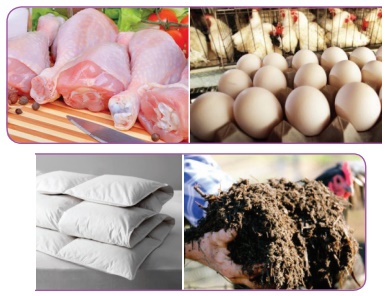
Do you know?
Egg contains minerals like calcium, phosphorus and sodium and vitamins like B1, B2 and D. Nutritious content of egg is: Water 66%, Protein 21%, Fat 9% and Minerals 3.5%.
* Poultry Diseases
If poultry animals are not cared or fed
properly, they suffer from a number of diseases.
→
Poultry birds affected by virus suffer from fever and diarrhea.
→
Foul cholera is caused in them by bacteria.
→
Over exposure to wet and cold conditions causes cramps in poultry birds.
→
Poultry birds are affected by internal parasites like round worm and tap worm.
They are also affected by external parasites like flees, lice, ticks etc.
Activity
4
Fill in the blanks using the words given below.
(Oilseeds, Egg, Honey,
Food grains, Fish)
Green Revolution: Foodgrains
Blue Revolution: Fish
Silver Revolution: Egg
Gold Revolution: Honey
Yellow Revolution: Oilseeds
* Poultry management
Poultry birds need a clean environment.
The following measures should be taken in order to avoid disases.
→
Poultry houses should be clean and disinfected.
→
It should have windows for ventilation.
→
Light is essential for high egg production.
→
Poultry birds need clean and fresh water.
→
Timely vaccination is necessary to prevent diseases.
II. Apiculture
Rearing of honey bee for honey is known
as apiculture. It is also called bee keeping. In this technique honey bees are
reared in a specially designed wooden box. Honey bees have been very closely
associated with humans since ancient times. Various products like honey and wax
are obtained from honey bees. Earlier honey is extracted from the hives in the
forests. Nowadays they are domesticated by farmers to produce honey. Bee
keeping is a profitable rural based industry. Honey bees are social insects.
The nest of honey bee is known as the bee hive. They live in colonies and show
division of labour
1. Types of Honey Bee
Three types of honey bee are found in a
colony. They are Queen bee, the Drones and the Worker bees.
* Queen Bee
The queen is the largest member of the
bee colony. There is only one queen and it is the fertile female of the colony.
They are formed from fertile eggs. The queen is responsible for laying eggs in
a colony. It lays about two thousand eggs per day. The life span of the queen
bee is 3-4 years.
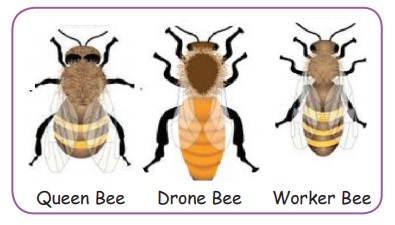
* Drones
Drones are the fertile males. They
develop from unfertilized eggs. They are larger than the workers and smaller
than the queens. Their main function is to fertilize the eggs produced by the
queen. They also help in maintenance of hive temperature. The number of drones
in a colony amounts to hundreds and sometimes to thousands. The normal
life-span of a drone is 57 days.
* Worker Bees
These
are sterile female bees and the smallest members of the colony. These bees are
very active. Their function is to collect honey, look after the young ones,
clean the comb, defend the hive and maintain the temperature of the bee hive.
Life span of worker bee is six weeks.
Do you know?
* One queen bee has to fly
90000 miles three times around the globe to make one pound of honey.
* Honey bee can fly up to
six miles and as fast as 15 miles per hour.
2. Useful products from Honey Bees
Honey and bee wax are obtained from
honey bees. Other products which are obtained from bees are bee venom, propolis
and royal jelly.
* Honey
Honey is a sweet, viscous, edible
natural food product. It contains proteins, free amino acids, vitamins and
minerals like calcium, iron, phosphorus and manganese. The following are the
uses of honey bees.
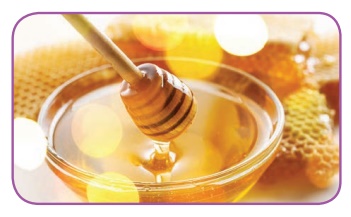
*
Honey has an antiseptic and antibacterial property. It is an antibiotic.
* It helps in building up haemoglobin
content in the blood.
* It is used in Ayurvedic and Unani
system of medicines.
* It prevents cough, cold, fever and relieves
sore throat.
* It enhances digestion and appetite.
* It provides essential aminoacids
required for the growth of the body.
Do you know?
Honey is the exciting
source of natural sweet. It is also called as ‘Liquid Gold’.
* Bee wax
Bee wax is secreted by the wax glands of
worker bee to construct the combs of bee hive. Some of the uses of bee wax are
given below.
* It is widely used in cosmetic
industry.
* The wax is used in the preparation of
shoe polish and manufacture of cold creams, lipsticks, candles and lubricants.
* It is also used in the preparation of
ointments and in pharmaceutical industry.
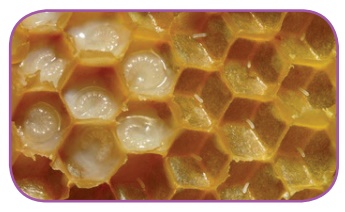
III. Manure
Manure is an organic matter used as
fertiliser. It is mostly derived from animal and plant residues. It increases the
fertility of the soil by adding nutrients such as nitrogen, phosphorus and
potassium. It is a natural form of fertiliser and it is cheaper.
1. Types of manure
Animal manure, green manure and compost
manure are the different types of manures.
* Animal manure
Common form of animal manure is the
farmyard manure. It contains the feces and urine of different livestock like
horses, cattle, pigs, sheep, chickens, turkey and rabbits. It contains
nutrients like nitrogen, phosphorus and potassium. It increases the capacity of
soil to hold more water and nutrients.
* Green manure
This is a manure obtained by
decomposition of green leaves, twigs of trees, shrubs and herbs. Leguminous
plants like clover are used for this purpose. These plants are ploughed in the
soil. They fix nitrogen in the root of the plants. They also help in
suppression of weeds and prevention of soil erosion.
* Compost
Compost is obtained by decomposition of
organic matter like crop residues, animal wastes and food wastes by various
microorganisms like bacteria and fungi under controlled conditions. These
microorganisms break down organic matter into simpler substances.
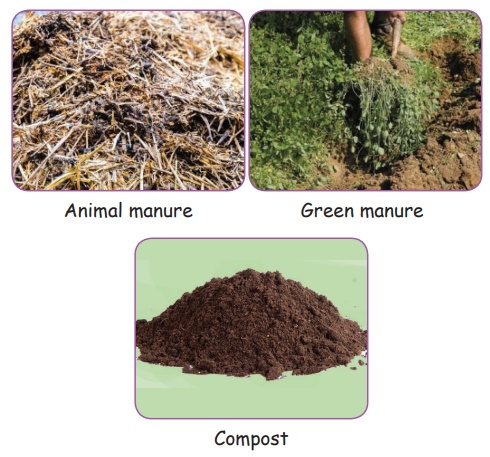
Activity 5
With the help of your teacher set up a compost pit within your school compound. Put all the organic wastes like food waste and cover it with soil. Wait for three weeks and then you can use this as manure for the plants in your school.
IV. Vermiculture
Vermiculture or Vermicomposting is a
method of transforming organic wastes such as waste papers, leaves, pieces of
woods etc., into a nutrient rich fertilizer using earth worms. It is a healthy
and clean way to eliminate wastes going into our landfills. It keeps the
environment clean. Earthworms eat the organic wastes and excrete it in the form
of castings. This is known as vermicompost. It is used as fertilizer for the
soil and it improves the properties of the soil.
1. Materials used for Vermicomposting
Organic matters which are biologically
degradable are used in vermicomposting.
Some of them are given below.
→
Crop residues like rice straw, rice husk, tea wastes and tobacco wastes.
→
Fruit and vegetable wastes.
→
Animal wastes like cattle dung, poultry droppings and droppings of goat and
sheep.
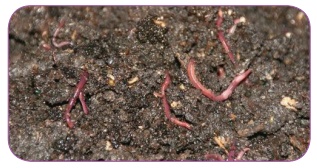
2. Advantages of Vermicompost
→
Vermicompost provides the essential nutrients such as nitrogen, potassium and
phosphorus for the plant growth.
→
It improves the water holding capacity of the soil and prevents soil erosion.
→
It enhances plant growth, suppresses diseases in plants, increases porosity and
improves water retention and aeration.
→
It reduces the need for chemical fertilizers.
Do
you know?
Common earth worms are not
used for vermicomposting. Specialized breeds that multiple while livingin
colonies are used for this. The most common are Red wigglers, European night
crawlers, and African night crawlers.
Related Topics